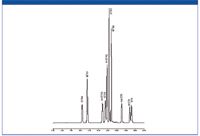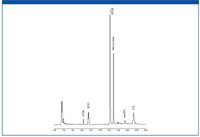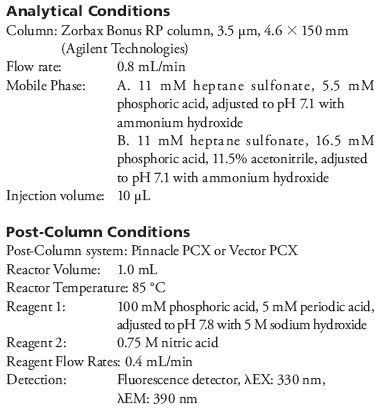Analysis of Paralytic Shellfish Toxins
The Application Notebook
The paralytic shellfish toxins are a group of 18 secondary metabolites deposited in bivalve mollusks by dinoflagelates. Dinoflagelate blooms are seasonal, occurring during warm months.
The paralytic shellfish toxins are a group of 18 secondary metabolites deposited in bivalve mollusks by dinoflagelates. Dinoflagelate blooms are seasonal, occurring during warm months. Since it is unpredictable whether the infestation will occur, the shellfish population should be regularly monitored for toxins. Ingestion of contaminated shellfish can lead to paralytic shellfish poisoning: a life-threatening illness.

Figure 1: Chromatogram of GTX and STX mixed toxins standard.
The Mouse Bioassay method used to detect dinoflagelate-derived neurotoxins has major drawbacks, which led to exploration of chromatographic methods of analysis. Recently, a HPLC method that utilizes post-column oxidation of the toxins under alkaline conditions has been approved as a new official AOAC method — OMA 2011.02. The products of post-column derivatization of the toxins can be detected with high sensitivity using a fluorescence detector, leading to the determination of toxin type and concentration. We describe the use of Pickering Laboratories post-column derivatization system for analysis of paralytic shellfish toxins according to AOAC Method 2011.02

Figure 2: Chromatogram of mussels sample naturally contaminated with paralytic shellfish toxins.

References
(1) J.M. van de Riet, R.S. Gibbs, F.W. Chou, P.M. Muggah, W.A. Rourke, G. Burns, K. Thomas, and M.A. Quilliam, J. AOAC Int.92, 1690–1704 (2009).
(2) AOAC Official Method 2011.02. Paralytic Shellfish Toxins in Mussels, Clams, Oysters, and Scallops. Post-Column Oxidation (PCOX) Method.
Pickering Laboratories, Inc.
1280 Space Park Way, Mountain View, CA 94043
tel. (800) 654-3330; fax (408) 694-6700
Website: www.pickeringlabs.com

Follow the Data to Grow: Why a Scientific Data Platform is Essential
October 28th 2024Innovation is the engine that powers a company’s growth and product development, and for enterprises with R&D laboratories, those lab environments are the greatest source of this innovation. In this white paper, learn how a platform approach to scientific data management, including semantic search, advanced analytics, and lab automation, leads to better enterprise decisions at the executive level, optimized lab performance, more discoveries, and stronger product pipelines.
















